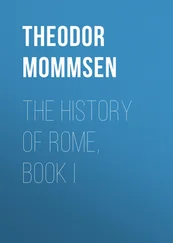Theodor Mommsen - The history of Rome
Здесь есть возможность читать онлайн «Theodor Mommsen - The history of Rome» весь текст электронной книги совершенно бесплатно (целиком полную версию без сокращений). В некоторых случаях можно слушать аудио, скачать через торрент в формате fb2 и присутствует краткое содержание. Жанр: История, Культурология, на английском языке. Описание произведения, (предисловие) а так же отзывы посетителей доступны на портале библиотеки ЛибКат.
- Название:The history of Rome
- Автор:
- Жанр:
- Год:неизвестен
- ISBN:нет данных
- Рейтинг книги:5 / 5. Голосов: 1
-
Избранное:Добавить в избранное
- Отзывы:
-
Ваша оценка:
- 100
- 1
- 2
- 3
- 4
- 5
The history of Rome: краткое содержание, описание и аннотация
Предлагаем к чтению аннотацию, описание, краткое содержание или предисловие (зависит от того, что написал сам автор книги «The history of Rome»). Если вы не нашли необходимую информацию о книге — напишите в комментариях, мы постараемся отыскать её.
The history of Rome — читать онлайн бесплатно полную книгу (весь текст) целиком
Ниже представлен текст книги, разбитый по страницам. Система сохранения места последней прочитанной страницы, позволяет с удобством читать онлайн бесплатно книгу «The history of Rome», без необходимости каждый раз заново искать на чём Вы остановились. Поставьте закладку, и сможете в любой момент перейти на страницу, на которой закончили чтение.
Интервал:
Закладка:
If, in conclusion, we glance back at the picture as a whole which the literature and art of Italy unfold to our view from the death of Ennius to the beginning of the Ciceronian age, we find in these respects as compared with the preceding epoch a most decided decline of productiveness. The higher kinds of literature - such as epos, tragedy, history - have died out or have been arrested in their development. The subordinate kinds - the translation and imitation of the intrigue-piece, the farce, the poetical and prose brochure - alone are successful; in this last field of literature swept by the full hurricane of revolution we meet with the two men of greatest literary talent in this epoch, Gaius Gracchus and Gaius Lucilius, who stand out amidst a number of more or less mediocre writers just as in a similar epoch of French literature Courier and Beranger stand out amidst a multitude of pretentious nullities. In the plastic and delineative arts likewise the production, always weak, is now utterly null. On the other hand the receptive enjoyment of art and literature flourished; as the Epigoni of this period in the political field gathered in and used up the inheritance that fell to their fathers, we find them in this field also as diligent frequenters of plays, as patrons of literature, as connoisseurs and still more as collectors in art. The most honourable aspect of this activity was its learned research, which put forth a native intellectual energy, more especially in jurisprudence and in linguistic and antiquarian investigation.
The foundation of these sciences which properly falls within the present epoch, and the first small beginnings of an imitation of the Alexandrian hothouse poetry, already herald the approaching epoch of Roman Alexandrinism. All the productions of the present epoch are smoother, more free from faults, more systematic than the creations of the sixth century. The literati and the friends of literature of this period not altogether unjustly looked down on their predecessors as bungling novices: but while they ridiculed or censured the defective labours of these novices, the very men who were the most gifted among them may have confessed to themselves that the season of the nation's youth was past, and may have ever and anon perhaps felt in the still depths of the heart a secret longing to stray once more in the delightful paths of youthful error.
Notes
Chapter I
The Subject Countries Down to the Times of the Gracchi
1. III. VII. The State of Culture in Spain.
2.Italica must have been intended by Scipio to be what was called in Italy forum et conciliabulum civium Romanorum ; Aquae Sextiae in Gaul had a similar origin afterwards. The formation of transmarine burgess-communities only began at a later date with Carthage and Narbo: yet it is remarkable that Scipio already made a first step, in a certain sense, in that direction.
3.III. VII. Gracchus.
4.The chronology of the war with Viriathus is far from being precisely settled. It is certain that the appearance of Viriathus dates from the conflict with Vetilius (Appian, Hisp. 61; Liv. lii.; Oros. v. 4), and that he perished in 615 (Diod. Vat. p. 110, etc.); the duration of his rule is reckoned at eight (Appian, Hisp. 63), ten (Justin, xliv. 2), eleven (Diodorus, p. 597), fifteen (Liv. liv.; Eutrop. iv. 16; Oros. v. 4; Flor. i. 33), and twenty years (Vellei. ii. 90). The first estimate possesses some probability, because the appearance of Viriathus is connected both in Diodorus (p. 591; Vat. p. 107, 108) and in Orosius (v. 4) with the destruction of Corinth. Of the Roman governors, with whom Viriathus fought, several undoubtedly belong to the northern province; for though Viriathus was at work chiefly in the southern, he was not exclusively so (Liv. lii.); consequently we must not calculate the number of the years of his generalship by the number of these names.
5.IV. I. Celtiberian War.
6.III. VII. Massinissa.
7.III. VI. Peace, III. VII. Carthage.
8.The line of the coast has been in the course of centuries so much changed that the former local relations are but imperfectly recognizable on the ancient site. The name of the city is preserved by Cape Cartagena - also called from the saint's tomb found there Ras Sidi bu Said - the eastern headland of the peninsula, projecting into the gulf with its highest point rising to 393 feet above the level of the sea.
9.The dimensions given by Beule (Fouilles a Carthage, 1861) are as follows in metres and in Greek feet (1=0.309 metre):
Outer wall 2 metres = 6 1/2 feet.
Corridor 1.9" = 6"
Front wall of casemates 1" = 3 1/4"
Casemate rooms 4.2" = 14"
Back wall of casemates 1" = 3 1/4"
Whole breadth of the walls 10.1 metres = 33 feet.
Or, as Diodorus (p. 522) states it, 22 cubits (1 Greek cubit = 1 1/2 feet), while Livy (ap. Oros. iv. 22) and Appian (Pun. 95), who seem to have had before them another less accurate passage of Polybius, state the breadth of the walls at 30 feet. The triple wall of Appian - as to which a false idea has hitherto been diffused by Floras (i. 31) - denotes the outer wall, and the front and back walls of the casemates. That this coincidence is not accidental, and that we have here in reality the remains of the famed walls of Carthage before us, will be evident to every one: the objections of Davis (Carthage and her Remains, p. 370 et seq.) only show how little even the utmost zeal can adduce in opposition to the main results of Beule. Only we must maintain that all the ancient authorities give the statements of which we are now speaking with reference not to the citadel-wall, but to the city-wall on the landward side, of which the wall along the south side of the citadel-hill was an integral part (Oros. iv. 22). In accordance with this view, the excavations at the citadel-hill on the east, north, and west, have shown no traces of fortifications, whereas on the south side they have brought to light the very remains of this great wall. There is no reason for regarding these as the remains of a separate fortification of the citadel distinct from the city wall; it may be presumed that further excavations at a corresponding depth - the foundation of the city wall discovered at the Byrsa lies fifty-six feet beneath the present surface - will bring to light like, or at any rate analogous, foundations along the whole landward side, although it is probable that at the point where the walled suburb of Magalia rested on the main wall the fortification was either weaker from the first or was early neglected. The length of the wall as a whole cannot be stated with precision; but it must have been very considerable, for three hundred elephants were stabled there, and the stores for their fodder and perhaps other spaces also as well as the gates are to be taken into account. It is easy to conceive how the inner city, within the walls of which the Byrsa was included, should, especially by way of contrast to the suburb of Magalia which had its separate circumvallation, be sometimes itself called Byrsa (App. Pun. 117; Nepos, ap. Serv. Aen. i. 368).
10.Such is the height given by Appian, l. c.; Diodorus gives the height, probably inclusive of the battlements, at 40 cubits or 60 feet. The remnant preserved is still from 13 to 16 feet (4-5 metres) high.
11.The rooms of a horse-shoe shape brought to light in excavation have a depth of 14, and a breadth of 11, Greek feet; the width of the entrances is not specified. Whether these dimensions and the proportions of the corridor suffice for our recognizing them as elephants' stalls, remains to be settled by a more accurate investigation. The partition-walls, which separate the apartments, have a thickness of 1.1 metre = 3 1/2 feet.
Читать дальшеИнтервал:
Закладка:
Похожие книги на «The history of Rome»
Представляем Вашему вниманию похожие книги на «The history of Rome» списком для выбора. Мы отобрали схожую по названию и смыслу литературу в надежде предоставить читателям больше вариантов отыскать новые, интересные, ещё непрочитанные произведения.
Обсуждение, отзывы о книге «The history of Rome» и просто собственные мнения читателей. Оставьте ваши комментарии, напишите, что Вы думаете о произведении, его смысле или главных героях. Укажите что конкретно понравилось, а что нет, и почему Вы так считаете.








